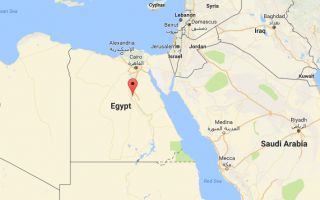Founded more than 3,000 years ago by the “heretic” Pharaoh Akhenaten and Queen Nefertiti, Amarna – officially Tell el-Amarna – is now considered one of the most accessible sites for studying urbanism, architecture and everyday life in pharaonic Egypt. And nearly every year since 2005, professor of anthropology Jerry Rose and his students have been traveling there to study the people who lived and died in this unique ancient city.
This summer, Rose and two of his doctoral students, Erika Morey and Cheyenne Lewis (both Middle East Studies and Doctoral Academy Fellows), are studying the remains from the south tombs cemetery at Amarna. The graves had been excavated by a team of archaeologists, sometimes including Rose, from 2006 to 2014. Unlike research that focuses on the ruling elites, “these skeletons represent the commoners who lived in this vast capital city of more than 30,000 people,” Rose explained.
 Morey and Lewis joined forces with a team from Southern Illinois University to conduct specialized studies, including 3D scanning, to complete the skeletal analyses, following up on previous research and filling in missing gaps in the data. The original research was published in the May 2017 issue of National Geographic.
Morey and Lewis joined forces with a team from Southern Illinois University to conduct specialized studies, including 3D scanning, to complete the skeletal analyses, following up on previous research and filling in missing gaps in the data. The original research was published in the May 2017 issue of National Geographic.
What the remains reveal to researchers is bleak. In contrast to the soaring temples and majestic palaces, the lives of the everyday workers at Amarna were hard and short. “It doesn’t look good,” Rose said. Malnutrition was so common, children’s growth was delayed by as much as two years. Overwork seems to have been common as well: “We see back trauma from the work load,” he said. One-third of Amarna’s residents died before the age of 15.
In addition to finishing up the previous research, Lewis and Morey are also collecting data for their dissertations.
Morey is studying dental decay and tooth loss among the ancient Amarna skeletons to determine how the ancient diet, reconstructed from plant remains, influenced dental health. One theory is that dust in the desert air in ancient Egypt caused rapid tooth wear and tooth loss, so she has posted devices to collect dust over a 21-day period to test this theory.
Lewis’ research focuses on sleep apnea, a condition that is currently being studied intensely in the healthcare field. Her research involves using 3D scans of jaws and facial shapes to reconstruct mouth and airway volume to find out how this high rates of crooked teeth, or malocclusion, affected Amarnans’ breathing and general health. Later, she will compare her results with modern clinical populations as part of a larger project investigating changes in the size of the jaws and airway passages of the mouth over the course of human history, and how they contribute to the development of sleep apnea.
Another noteworthy aspect of this summer’s projects is that two graduate students from the separate universities – U of A and Southern Illinois University – formed a collaborative team to enhance the mutual collection of data for their dissertations. Kaleigh Best (SIU) is studying the differences in head and limb bone shapes between males and females; Lewis is examining jaw and facial shapes. Prior to leaving for Egypt, Best and Lewis devised a way to work and share their data to more efficiently accomplish their research goals. They both brought their respective university’s NextEngine 3D scanners and fast laptops to scan as many skeletons as possible during their month at the research station. They worked side by side in the facility’s darkroom and shared their scan files in order to complete as many of these time-consuming scans as possible. “By agreeing to collaborate, we will together be able to collect twice the data during our month here in Egypt and enhance both of our research projects,” Best and Lewis wrote.
The U of A’s portion of this year’s project was funded by the King Fahd Center for Middle East Studies.





You must be logged in to post a comment.